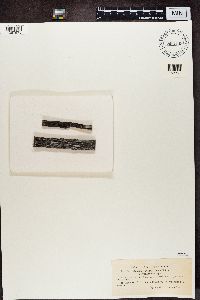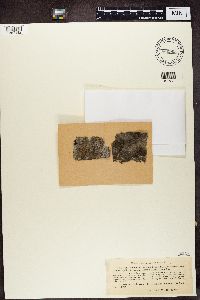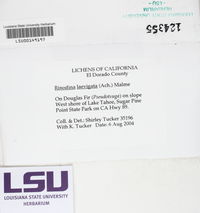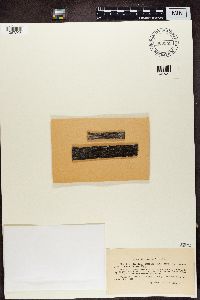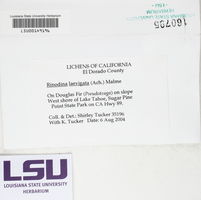Rinodina laevigata
|
|
|
|
Family: Physciaceae
[Lecanora laevigata (Ach.) Röhl., moreLecanora laevigata f. dispersella Vain., Lecanora laevigata f. laevigata Ach., Lecanora sophodes var. laevigata Ach.] |
MB#404383 Basionym. Lecanora sophodes var. laevigata Ach., Lich. univ. 357 (1810). Rinodina subfusca H. Magn., Acta Horti Gotob. 17: 240 (1947). Exsiccata. Crypt. Exs. Vind. 3724 (COLO, K in BM); Hasse Lich. Exs. 204 (SBBG); Macoun Can. Lich. 126 (MU as R. sophodes var. confragosa); Weber Lich. Exs. COLO 206 (UC as R. archaea, pro parte with R. endospora). Description. Thallus inconspicuous, or thin, scabrid, dark grey to brown, areolate; areoles to 0.2-0.30 mm wide merging to form a continuous thallus; surface plane to minutely rugose, matt; margin indeterminate or determinate; prothallus lacking, except rarely when adjoining thalli of other species, then narrow, dark, entire, rarely fimbriate; vegetative propagules absent. Apothecia broadly attached, becoming narrowly attached, frequent, sometimes contiguous, to 0.40-0.90 mm in diam.; disc black, plane sometimes becoming convex; thalline margin 0.05-0.10 mm wide, concolourous with thallus, entire, rarely incompletely formed, then crenulate; excipular ring absent or raised. Apothecial Anatomy. Thalline exciple 40-70(-80) µm wide laterally; cortex 5-20 µm wide; crystals absent in cortex and medulla; cortical cells to 4.0-8.0 µm wide, pigmented or not; algal cells to 9.0-17.0 µm long; thalline exciple 55-100 µm wide below; cortex 20-50(-65) µm deep, hyphae intricate; proper exciple hyaline, 5-20 µm wide laterally, expanded to 20-30 µm at periphery; hypothecium hyaline, 40-90(-110) µm deep; hymenium 70-110 µm high, not inspersed; paraphyses 2.0-2.5 µm wide, not conglutinate, with apical cells 3.5-5.5(-7.0) µm wide, pigmented, immersed in dispersed pigment forming a dark, red-brown epihymenium; asci 50-70 x 17-22 µm. Ascospores 8/ascus, Type A development, Physcia-type, (14.5-)18.5-19.5(-22.5) x (7.0-)8.5-9.0(-10.5) µm, average l/b ratio 2.0-2.3, lumina becoming inflated but retain thickened apical wall, cells sometimes with slightly pigmented wall bands; torus present; walls ornamented or not. Pycnidia not seen. Chemistry. Spot tests all negative; secondary metabolites not detected. Substrate and Ecology. Found on small twigs of deciduous, more rarely coniferous, trees or stems of shrubs in mesic habitats from sea level in the northwest to 2 685 m in southern California. Recorded on Abies concolor, A. magnifica, Acer macrophyllum, Alnus crispa, A. incana, A. rubra, Cercis occidentalis, Cornus nutallii, Crataegus, Cupressus abramsiana, Cystus scoparius, Fraxinus latifolia, Holodiscus discolor, Juglans, Picea sitchensis, Populus trichocarpa, Prunus, Pseudotsuga menziesii, Quercus agrifolia, Q. chrysolepsis, douglasii, Q. garryana, Q. kellogii, Rhamnus purshiana, Robinia and Tsuga heterophylla. Frequently collected with other species including Rinodina aurantiaca, R. badiexcipula, R. californiensis, R. capensis, R. disjuncta, R. endospora, R. exigua, R. marysvillensis, R. metaboliza, R. oleae, R. orculata, R. oregana, R. polyspora, R. pyrina, R. santae-monicae and R. trevisanii. Distribution. Western North America from Alaska to California where it is frequent in the Coastal Ranges from British Columbia to southern California. Also found in the Sierra Nevada and high rainfall forests in the Rocky Mountains on either side of the international border. Rinodina laevigata is the most widely distributed of the oceanic, Pacific species, this being one reason for the large number of Rinodina species that it has been collected with. A north temperate species known from Scotland, Scandinavia and adjacent Russia (Mayrhofer and Moberg 2002). Notes. Rinodina laevigata is a rather variable species characterized by its Physcia-type spores, the thin, poorly developed and often scabrid thallus, and by the usually thick lower apothecial cortex with intricate hyphae. The thickness of this cortex is quite variable and is related to the size of the apothecia and the relative narrowness of the apothecial base as in some other species. It differs from R. archaea in its less well developed thallus and smaller, Physcia- rather than Physconia-type spores. Although the description above matches that of Mayrhofer and Moberg (2002) rather well, the variability of this species is such that it is possible that more one taxon has been included under the name. Rinodina subfusca was included in R. septentrionalis by Mayrhofer and Moberg (2002) but the grey colour and morphology of the thallus, larger size of the apothecia, expanded lower cortex and the less prominent torus are all characteristic of R. laevigata. Specimens examined. CANADA. BRITISH COLUMBIA. Bald Cove, W.J. Noble 561B (UBC); Blaeberry River road, J.W. Sheard 5285 (SASK); Fernie, C.M. Wetmore 18718B (COLO, MIN, WIS); Haida Gwaii (Queen Charlotte Islands) Copper Bay, I.M. Brodo 17258; Sandspit, I.M. Brodo 10079a, 10090; Skidegate Inlet, I.M. Brodo 11179 (all CANL); Highland, W.J. Noble 3986f (UBC); west end Lillooet Lake, I.M. Brodo 8312 (CANL, COLO); Mica Creek Village, T. Goward 2895a (personal herb.); Robbers Island, I.M. Brodo 11176a (CANL); S Pender Island, W.J. Noble 289c (UBC); SSE Revelstoke, T. Tønsberg 26328; Saltspring Island, Mount Maxwell, T. Tønsberg 12701 (both BG); 14 mi S Squamish, I.M. Brodo 8159 (CANL, PMAE, WIS); Vesuvius, C.D. Bird 28383 (PMAE); Victoria, 1893, J. Macoun (CANL). U.S.A. ALASKA. Chilkoot Trailhead, T. Tønsberg 32961 (BG); Chisik Island, S. Talbot 303 (WIS); Kodiak Island, S Monashka Bay, T. Tønsberg 15656 (BG). CALIFORNIA. Calaveras Co., Arnold, I. Tavares 299 (UC); Del Norte Co., Rte 199 S Oregon/California border, T. Tønsberg 14690a, 14704 (BG); El Dorado Co., S Sugar Pine Point, S.C. Tucker 38509; 2 mi E Kyburz, S.C. Tucker 34017; 3 mi E Kyburz, S.C. Tucker 34110b, c; Lake Co., 'The Slides', S.C. Tucker 35375b, c; 8 mi NE Potter Valley, S.C. Tucker 35461; Clear Lake State Park, S.C. Tucker 31692c; near Lakeport, S.C. Tucker 31667; near Pillsbury Resort, S.C. Tucker 35375a (all SBBG); Los Angeles Co., Mount Mooney Road, B.D. Ryan 27207 (ASU); San Gabriel Mountains, 1897, H.E. Hasse 518 (US); San Gabriel Wilderness, M. Neel SC121; Madera Co., NW Rock Creek Campground, B.D. Ryan 32170, 32174b; Rock Creek, B.D. Ryan 32166a, 32168 (all ASU); Shaver Lake, R. Mayer 93740b (LSU); Marin Co., Mount Tamalpais, I. Tavares 1568c (UC); Point Reyes Peninsula, S.C. Tucker 28906b (SBBG); Mariposa Co., Yosemite Valley, 1900, H.E. Hasse (FH); Mendocino Co., I. Tavares 1346b (UC); near Lakeport, I. Tavares 1346b (SASK); Monterey Co., Anastasia Canyon, I. Tavares 89f (UC); I. Tavares 92d (UC); Arnold Canyon, I. Tavares 2158a (SASK); Carmel Valley, I. Tavares 2117, 2158a, 2191, 2209 (UC); Hastings Natural History Preserve, S.C. Tucker 34586C (SBBG); Napa Co., Calistoga, I. Tavares 1358 (UC); Riverside Co., Fuller Mill Creek, C.M. Wetmore 14689 (SASK); Humber Park, P. van den Boom 25170 (personal herb.); San Diego Co., 2 mi SSE Eagle Crag, B.D. Ryan 25975; San Luis Obispo Co., 3 km ESE Pozo, L. Ross 235 (both ASU); Hearst Castle, S.C. Tucker 36549; San Mateo Co., Skyline Drive, S.C. Tucker 13423a; Santa Barbara Co., Bates Canyon Camp, S.C. Tucker 28852; Figuera Mountain, S.C. Tucker 35900; Sage Hill Campground, S.C. Tucker 35321a (all SBBG); Santa Clara Co., Loma Prieta, A.C. Herre 2415 (UPS); Santa Cruz Co., Bonny Doon, I. Tavares 2064 (UC); Shasta Co., 1 mi N Lamoine, S.C. Tucker 37164 (SBBG); 4 mi SE Dunsmuil, B.D. Ryan 26712b; Siskijou Co., 3 mi NE Seiad Valley, B.D. Ryan 25685, 25692, 25693, 25697 (all ASU); Solano Co., Vaca Mountains, S.C. Tucker 37478 (SBBG); Sonoma Co., 3 mi E Spring Mountain Range, I. Tavares 1323C (UC); Sugar Loaf Ridge, S.C. Tucker 37789 (SBBG); Tulare Co., Grant Grove, J.L. Blakeman 125; Sequoia Nat. Park, C.M. Wetmore 50679 (both MIN); Tuolumne Co., E Sonora, S.C. Tucker 38632 (SBBG). IDAHO. Idaho Co., Lochsa River Valley, T. Tønsberg 26587 (BG); Lewis Co., Mohler, W.B. Cooke 25082 (WIS). MONTANA. Silver Bow Co., Missoula, R.A. Anderson 4900 (COLOM). OREGON. Benton Co., 0.7 km W Blodgett, B. McCune 20144 (personal herb.); 14 mi W Corvallis, I.M. Brodo 20933, 25324; 7 mi S Philomath, I.M. Brodo 20947 (all CANL); Corvallis, B. McCune 16408, 17993, 20056, 26489; N Corvallis, B. McCune 25198 (all personal herb.); Philomath, C.M. Wetmore 24531 (MIN); Douglas Co., 3 km Tenmile, B. McCune 25704; Rock Creek Drainage, B. McCune 23680 (both personal herb.); Josephine Co., Grant's Pass, L.H. Pike 56962 (PMAE); C.M. Wetmore 24480b (MIN); Selma, 1969, L.H. Pike (CANL); Lane Co., Franklin, P. Neitlich 763 (McCune personal herb.); Linn Co., Crabtree Valley, B. McCune 19639; Horse Rock Ridge, B. McCune 22327b, 24320 (both personal herb.); Tombstone Pass, I. Tavares 127a (UC); Marion Co., Salem, 1871, E. Hall (FH). WASHINGTON. San Juan Co., San Juan Island, I.M. Brodo 15552 (CANL). Selected References. Magnusson (1947a), Mayrhofer & Moberg (2002 p. 104), Sheard (2004). Nash, T.H., Ryan, B.D., Gries, C., Bungartz, F., (eds.) 2004. Lichen Flora of the Greater Sonoran Desert Region. Vol 2. Thallus: crustose, evanescent or thin and scabrid, sometimes areolate, areoles <0.2 mm wide, plane to minutely rugose surface: gray to brownish, dull; margin: indeterminate; prothallus: lacking; vegetative propagules: absent Apothecia: adnate, becoming sessile, frequent, sometimes contiguous, up to 0.4-0.9 mm in diam. disc: black, plane sometimes becoming convex thalline margin: 0.05-0.1 mm wide, concolorous with thallus, entire, rarely incompletely formed, then crenulate with excipular ring: raised thalline exciple: 40-65 µm wide laterally; cortex: 5-15 µm wide; cells: up to 4-6 µm wide, pigmented or not; algal cells: up to 10-17 µm in diam.; thalline exciple: c. 60-90 µm wide below; cortex: to 20-30 µm thick, hyphae intricate to columnar proper exciple: hyaline, (5-)10-15 µm wide laterally, expanded to 20-30 µm at periphery hymenium: 70-100 µm tall; paraphyses: c. 2.5 µm wide, not conglutinate, with apical cells up to 3.5-5 µm wide, pigmented and immersed in dispersed pigment forming a red-brown epihymenium; hypothecium: hyaline, 40-90 µm thick asci: clavate, 50-70 x 17-18 µm, 8-spored ascospores: brown, 1-septate, ellipsoid, type A development, Physciatype, (14-)17-18.5(-21) x (7-)8.5-9.5(-10.5) µm, lumina becoming inflated but retaining thickened apical wall, cells sometimes with slightly pigmented bands; torus: present; walls: ornamented or not Pycnidia: not seen Spot tests: all negative Secondary metabolites: not reported. Substrate and ecology: mostly on small twigs of deciduous trees World distribution: Scandinavia and adjacent Russia and western North America (Alaska to California, frequent in coastal ranges) Sonoran distribution: coastal ranges of southern California. Notes: Northern populations correspond closely to material from Scandinavia (Mayrhofer and Moberg 2002) although the spores may be somewhat larger. The Californian population often has smaller spores with more persistently angular lumina and sometimes better developed thalli, that may be gray rather than pale brown. Smaller apothecia, typical of this population, have a less well-developed lower apothecial cortex. It may prove to be a separate taxon upon further study. |





